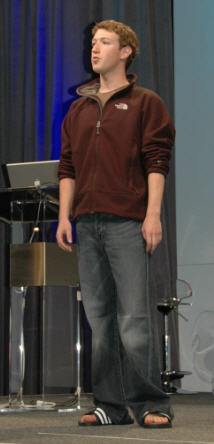Facebook's Zuckerberg uncorks the social graph

Facebook CEO Mark Zuckerberg took the stage in jeans, Adidas shower shoes and Northface polar fleece and told that crowd that they were at the beginning of a new movement. He then described the recent growth of the company and to the company's secret sauce--the social graph (see my earlier post).

The 23-year-old got a bit off his stride when the slides failed to work, but quickly got back on track. "Facebook is the sixth most trafficed site in the U.S. and we can seem to get our act together," he quipped.
Then he said, "We recently passed eBay in traffic and we are working on passing Google too." Facebook has twice as much traffic as any other photo application without all kinds of bells and whistles, he said Why he asked. "It has access to people's real connections and that trumps everything else," he said. Facebook has more traffic for events than other site, he claimed.
Zuckerberg attributed the power of Facebook to the "social graph, ” the network of connections and relationships between people on the service. He said, "It's the reason Facebook works."
"Its changing the way the world works," he said, pushing information out faster than any big company can. "As Facebook adds more and more people with more and more connections it continues growing and becomes more useful at a faster rate. We are going to use it spread information through the social graph." The net effect of the social graph is that groups and application can achieve exponential growth, he said.
"The Facebook platform is optimized for building applications in Facebook, and with more value for people to develop on our base than we could do on our own. People are already building social apps, but they have to reconstruct the social graph all by themselves. We are going to allow developers worldwide to do complete new things. Today social networks are completely closed nets...today we are going to end that. With this [framework] any developer worldwide can build full applications on top of the social graph inside the Facebook Platform."
Gina Bianchini, CEO of Ning, which makes another social networking service doesn't agree that Facebook is going to bring the end closed social networks. “All freedom is good, but when people get a taste of type of freedom Facebook is launching today, they want more than a bite. A tightly controlled service can be successful, but fundamentally people want freedom at every level," she said.
Facebook is open to third parties to integrate on top of the service, but you do have to inhabit the Facebook's walled garden, social graph. On the other hand, a controlled environment like Facebook can leverage the huge network of people and allows for targeted innovation.
"Facebook is following in the venerable and profitable footsteps of Microsoft by opening up to developers," said Max Levchin, CEO of Slide. He noted that the top three companies living off the Microsoft platform have $40 billion in market cap. Levhcin said the the next Intuit, EA, and Adobe will be creating on top of the "new operating system"--Facebook.
Zuckerberg identified deep integration into the Facebook Platform, mass distribution via the social graph and newbusiness opportunities as the three major themes of the announcement.
Facebook will allow users to make money, such as selling ads or conducting transactions, through "canvas" pages (not profile pages). Users get to keep all the revenue and choose whatever ad delivery system they want. "For transactions, you don't have to send people off the site to process transactions, so you don't have to redirect users of another site. This is good for us because if developers build great applications then they are providing a service to our users and strengthening the social graph."
Zuckerberg ended his remarks, saying that the Facebook movement, creating a more open environment, would be built one application at a time. The building begins tonight, when the Facebook Platform is released to the masses, Zuckerberg said.